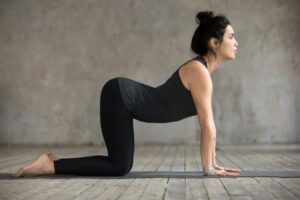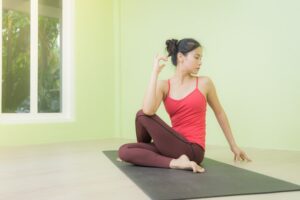Table of Content
Summary
Spine health affects the whole body. The spine must be kept strong and flexible to avoid lower back pain and neck pain. Bad posture causes an imbalance of muscles, stiffness and spinal misalignments. Yoga is helpful in strengthening the spine, creating balanced muscle growth and relieving compression in the back. In this article, we will take you through a series of yoga postures (asanas) to help strengthen the back and relieve any back pain. This is a holistic solution, and keeps the pain away long term. These postures are best when performed in order, to warm up, stretch, twist and warm down the spine.
Why spine health matters
The spine is an important bone structure that connects the lower body, the upper body and the head. It is crucial to keeping our bodies upright and the ability to walk. The spine is a complex network of vertebrae (spinal bones), intervertebral disks (shock absorbers), spinal cord and nerves, muscles and ligaments. The spine is highly flexible structure, with a surprising amount of strength given its configuration. The spine is divided into 4 sections – cervical spine (neck), thoracic spine (upper back), lumbar spine (lower back) and the Sacrum and coccyx (hips). For good posture, the 4 parts of the spine are typically stacked on top of each other, keeping them in a stable position.
Posture and stress significantly impact the spine. Bad posture, such as chronic slouching or hunching over, can cause an imbalance between muscles in the front and back of the body. This puts a lot of stress on the back muscles and causes chronic back pain. Not using the full range of motion of the spine can also be detrimental and result in stiffness. If you don’t use it, you lose it. Stiffness and muscle imbalance can increase chances of injury, spinal misalignment and nerve compression.
How does yoga help?
Yoga is a holistic practice that prioritizes mind and body health. Yoga postures engage different muscle groups and focus on balance and co-ordination. The core and the spine are almost always engaged while performing yoga. A regular yoga practice can help strengthen the back muscles and improve posture as well as spinal flexibility. The practice would involve both static and dynamic postures, resulting in a greater range of motion. Yoga also helps the body re-establish the relationship between the deep core muscles and the back muscles. This is the most important step to keeping the muscles in the front and the back of the body balanced.
A regular yoga practice takes your spine through stretches, rotational movements, side bends and extensions. The practice also focuses on rest and bringing the spine back to its correct stable position. A yoga practitioner pays close attention to spinal alignments in all postures. In modern daily life, it is rare to organically incorporate the full range of spinal movements into our daily activities. Hence, to maintain full spinal mobility, especially after the age of 40, yoga is highly beneficial.
According to spinal surgeons, people suffering from back pain and back injuries can still practice yoga, under careful supervision. As long as the yoga instructor is informed of the injury, they can provide alternate asanas to avoid straining the back, while still subtly strengthening and stretching the area. Yoga can also help reduce stress and improve blood circulation which naturally helps in recovery from injuries.
Postures for Spine Health
It is counterintuitive for us to move more when we are in pain. We think that when our bodies hurt, we should just lie in bed and rest. Yoga tells us that when our bodies hurt, we must move cautiously and strengthen the muscles which are weak. Practicing asanas (yoga postures) when you have back pain is a quick and easy strategy that you can try at home. You just need a yoga mat or soft carpet and a little space. Here are some asanas you can try at home to relieve your back pain:
 Cat-Cow pose – This is a gentle warm up for the spine, and should be the first asana you do in your spine routine. It works the entire length of the spine, and stretches your torso, shoulders and neck.
Cat-Cow pose – This is a gentle warm up for the spine, and should be the first asana you do in your spine routine. It works the entire length of the spine, and stretches your torso, shoulders and neck.
To perform the posture, first get on your hands and knees. The palms are planted on the mat, directly under the shoulders. The knees are under the hips. Balance your weight equally on all fours. Inhale and look up, as you arch your back and drop your stomach towards the mat. Keep your awareness on your body and how it feels as you perform the asana. Exhale and tuck your chin into your chest. Draw the navel towards the spine and arch your back towards the ceiling. You can perform this movement fluidly for about a minute to warm up the spine.
 Downward-facing Dog pose – This is one of the most widely-recognised yoga poses. This is a simple inversion which helps lengthen the spine. This pose helps relieve back pain and work out the imbalances in your muscles.
Downward-facing Dog pose – This is one of the most widely-recognised yoga poses. This is a simple inversion which helps lengthen the spine. This pose helps relieve back pain and work out the imbalances in your muscles.
To get into the pose, go down on the mat on all 4s with your shoulders and wrists stacked. Hips and knees are also stacked on top of each other. Tuck your toes and lift your knees off the mat, pressing into your palms. Visualise pushing your hips up to the sky. A deceptively simple pose, you can bend your knees slightly if you find your back arching while in this pose. Distribute your weight evenly between all 4 limbs.
Sphinx pose – This pose is a gentle back-bend warm up. It strengthens your spine and glute muscles. It also helps relieve stress. Remember to breathe normally in this pose; don’t hold your breath.
Lie on your stomach with your arms above your head. Place your elbows below your shoulders with forearms on the mat, bring your shoulders away from the neck, and lift your chest off the mat. Breathe while focussing into your lower back muscles.
 Cobra pose – The Cobra pose is similar to a sphinx pose, but gives you a deeper stretch. This pose is known to relive lower back pain, and improve postural issues like slumping shoulders and forward head posture (text neck).
Cobra pose – The Cobra pose is similar to a sphinx pose, but gives you a deeper stretch. This pose is known to relive lower back pain, and improve postural issues like slumping shoulders and forward head posture (text neck).
We start again lying face down on the mat, with our arms by the sides of the chest. Place your palms below your shoulders, with fingers facing forward. Press into the palms and slowly lift your head, neck and chest off the mat. Keep your elbows tucked in, close to the torso, while keeping them slightly bent. Look up and keep breathing. You can also let your head drop back and deepen the stretch.
Locust pose – This is an advanced back bend that can help relieve lower back pain and fatigue. You can build up to doing this pose by doing sphinx pose and cobra pose first. This pose creates a good stretch along the front of the body to counteract constant slouching. It strengthens the upper and lower back, and tones the glutes and hamstrings.
To do the locust pose, begin lying face down on your stomach. Keep your arms stretched back, with hands resting near the thighs. Breathe in, and lift up both your arms, both your legs, head, shoulders and upper chest off the mat in one smooth movement. Breathe naturally. Keep your body balanced on both sides; Make sure you are not twisting. Keep the core and thighs engaged and look forward.
Bridge Pose – This is an easy back bend and an inversion posture. It stretches the spine and relieves back pain and headache. The posture opens the chest and lungs and stretches the thighs.
To get into the bridge pose, start by lying on your back with your feet flat on the floor, shoulder width apart. Keep your knees bent. Place your hands along your torso, palms facing down. Inhale deeply. As you exhale, push your hips up towards the ceiling, while pushing down on your feet. Press down on your palms to stabilise yourself and hold the pose. Keep breathing naturally, and keep your head, neck and shoulders relaxed on the floor. If you have bad back pain, you can support your lower back with your hands during this pose.
 Half Lord of the Fishes pose – This twisted seated pose creates a dynamic stretch on the spine, engages the spine’s full range of motion and also stimulates internal organs in your abdomen.
Half Lord of the Fishes pose – This twisted seated pose creates a dynamic stretch on the spine, engages the spine’s full range of motion and also stimulates internal organs in your abdomen.
To begin, sit on the mat with your legs stretched out in front of you. You should be able to feel both the sit bones making stable contact with the ground. Lengthen your spine by stretching your arms up. Bring your arms back down. Cross your right leg next over the left leg and place your right foot down next to your left knee. Place your right arm behind you and twist your body to the right. Do not shift your hips while you twist, and keep your sit bones grounded. Hug your right knee with your left arm. Breathe at a natural pace. Hold for 5 to 8 breaths. Try to twist a little deeper with every exhalation.
Child’s Pose – Child’s pose is a resting forward fold posture, giving you the perfect counter stretch to end your yoga routine. It releases tension in the neck and back, while lengthening and stretching the spine. This pose helps relieve stress and relaxes the entire body.
Sit back on your heels with your knees together. Stretch your arms up to lengthen your spine. Inhale here. As you exhale, fold forward and bring your body down to rest on your thighs. You can use a folded up towel or small cushion, or rest your forehead on the mat. As you breathe, visualise letting go of the tension in your back. You can rest in this pose for up to 5 minutes to end your routine.
Prioritize your spine health with these yoga tips and stay pain-free. For personalized care and expert medical advice, visit Kauvery Hospital. With spinal surgeons and specialists available at our branches in Chennai, Hosur, Salem, Tirunelveli, and Trichy, we’re here to support you in maintaining optimal spine health. Reach out to us for a consultation today.
Kauvery Hospital is globally known for its multidisciplinary services at all its Centers of Excellence, and for its comprehensive, Avant-Grade technology, especially in diagnostics and remedial care in heart diseases, transplantation, vascular and neurosciences medicine. Located in the heart of Trichy (Tennur, Royal Road and Alexandria Road (Cantonment), Chennai (Alwarpet & Vadapalani), Hosur, Salem, Tirunelveli and Bengaluru, the hospital also renders adult and pediatric trauma care.
Chennai Alwarpet – 044 4000 6000 • Chennai Vadapalani – 044 4000 6000 • Trichy – Cantonment – 0431 4077777 • Trichy – Heartcity – 0431 4003500 • Trichy – Tennur – 0431 4022555 • Hosur – 04344 272727 • Salem – 0427 2677777 • Tirunelveli – 0462 4006000 • Bengaluru – 080 6801 6801



